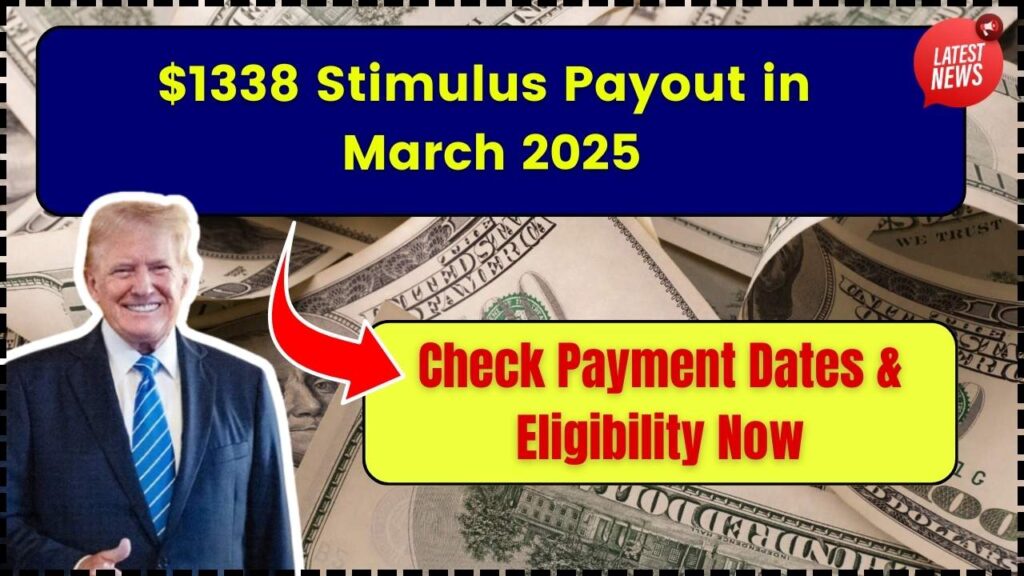$1338 Stimulus Payout in March 2025: In recent years, the U.S. government has provided various financial relief packages aimed at helping Americans deal with economic disruptions, particularly during the COVID-19 pandemic. Now, as discussions intensify over the potential $1338 stimulus payout in March 2025, many are eager to understand what this could mean for them. This article will break down everything you need to know about this proposed stimulus, including eligibility, expected payment dates, and how to check if you qualify.

$1338 Stimulus Payout in March 2025
| Key Topic | Details |
|---|---|
| Proposed Stimulus Amount | $1338 |
| Proposed Distribution Date | March 2025 (Tentative) |
| Eligibility | U.S. residents; income thresholds apply |
| How to Check Status | IRS website or your tax professional |
| Where to Get More Information | IRS Official Website |
The $1338 stimulus payout in March 2025 could provide essential financial relief to millions of Americans, but it’s important to stay informed and understand how you may be affected. By checking eligibility, filing your taxes, and staying on top of updates from the IRS, you can ensure that you get the support you need.
What is the $1338 Stimulus Payout?
The $1338 stimulus payout is a proposed financial relief check that is being discussed for potential distribution in March 2025. While not yet officially approved, this amount is part of ongoing conversations in Washington to provide support for Americans affected by rising living costs, inflation, and economic challenges. This payment could serve as a direct stimulus payment to individuals, designed to bolster consumer spending and provide temporary relief for households facing financial hardship.
This stimulus is expected to resemble past Economic Impact Payments (EIPs) that were distributed during the COVID-19 pandemic, but the amount, eligibility, and details will likely differ slightly.
Eligibility for the $1338 Stimulus Payment
Eligibility for the $1338 stimulus payout will depend on various criteria such as income, filing status, and family size. Although the details are still under discussion, we can take a look at how past payments were distributed to predict what to expect for this one.
1. Income Thresholds
Similar to previous rounds of stimulus checks, there will likely be income limits that determine how much, if any, of the stimulus payment you’ll receive. Here’s what we know from past payment structures:
- Single Filers: If your adjusted gross income (AGI) is below $75,000, you are likely eligible for the full payment. If your income exceeds this amount, the payment will gradually decrease.
- Married Filing Jointly: For married couples filing jointly, the full payment threshold is typically around $150,000.
- Heads of Household: For heads of household (usually single individuals supporting dependents), the income limit is typically $112,500.
Above these thresholds, the payment amount will decrease progressively. Those with income exceeding a certain limit (often above $100,000 for individuals) may not receive a payment at all.
2. Filing Status and Dependents
Your filing status plays a big role in your eligibility for the stimulus payment:
- Single Filers: To qualify for the full $1338, you will need to fall under the income limits set by the government.
- Married Filing Jointly: If you’re married and file jointly, the eligibility amount could potentially be doubled, which means both spouses could receive a combined $2676 if both meet the income thresholds.
- Heads of Household: If you are a head of household, the rules will mirror the single filer threshold but may provide additional benefits for dependents.
3. Additional Factors
Eligibility is also determined by your U.S. citizenship or permanent residency status. If you are an undocumented immigrant, you are not eligible for this stimulus payment. Additionally, you must have a valid Social Security Number (SSN) to qualify.
How to Check Payment Dates and Status
Once the $1338 stimulus payout is officially confirmed and distributed, it’s important to know when and how you will receive your payment. Here’s how to stay up to date:
1. Visit the IRS Website
The IRS website will be your primary source for accurate, up-to-date information regarding payment dates. Once the payments are announced, the IRS will likely set up a tool that allows you to check the status of your payment.
This tool will show you when your payment is scheduled to arrive, whether it’s been sent, and how it’s being delivered (direct deposit or physical check). If there are any issues with your payment, the IRS website will have clear instructions for how to resolve them.
2. Check Your Bank Account or Mailbox
Once the payment is processed, the IRS typically distributes stimulus checks via direct deposit to individuals who have previously filed taxes and provided their banking information. For those who do not have direct deposit set up, a paper check may be issued instead. Be sure to check both your bank account and your mailbox regularly for the payment.
3. Consult Your Tax Professional
If you’re unsure about your eligibility, payment status, or whether you need to take any action, consider consulting a tax professional. They will have the most accurate and up-to-date information regarding the stimulus payout and can help you navigate any potential issues.
How the $1338 Stimulus Payment Will Impact the Economy
One of the key reasons for the stimulus payout is to stimulate consumer spending and provide much-needed relief to American households. With inflation rising, many families are struggling to make ends meet. If the $1338 payment is approved, it could provide a temporary financial cushion for millions of Americans.
In the past, stimulus checks have been shown to increase spending in the economy, especially in areas like consumer goods, housing, and small businesses. By providing direct payments to individuals, the government aims to boost economic activity and help reduce the financial strain many Americans are experiencing.
Common Concerns about Stimulus Payments
1. Will I Receive the Full $1338 Amount?
As previously mentioned, eligibility is based on your income level and filing status. If you earn above the income thresholds, the payment will be reduced or eliminated altogether.
2. What if I Am Self-Employed?
Self-employed individuals are eligible for the same stimulus payments as other Americans, provided they meet the eligibility criteria. If you are self-employed, ensure that you have filed your taxes properly and meet the required income limits.
3. Can I Get the Payment if I Don’t File Taxes?
If you haven’t filed taxes recently and your income is below a certain threshold, you will need to file a non-filer form with the IRS. This form allows you to claim the stimulus payment without having filed a tax return.
$5,000 Fines Imposed on Thousands for These Tax Filing Errors: Check How to Avoid Them!
USA $500 Monthly Checks Payment Coming or not? Is it true? Check Status, Eligibility
FAQs About $1338 Stimulus Payout in March 2025
1. When will the $1338 stimulus payments be issued?
The March 2025 timeline is the current estimate, but keep an eye on the IRS website for official announcements and exact payment dates.
2. What if I haven’t received my payment?
If you qualify for the stimulus payment and haven’t received it, you should check your IRS status online or contact your tax professional to resolve any issues.
3. Will this payment be taxable?
No, stimulus payments are not taxable. They are considered non-taxable income.
4. How do I know if I qualify for the stimulus payment?
Check the income limits and filing status requirements. You can also use the IRS tool once the payments are announced to check if you qualify.
How to Maximize Your Stimulus Payment
While waiting for your payment, here are a few tips to ensure you maximize your benefits:
- Ensure Direct Deposit: If you have a bank account and haven’t already set up direct deposit with the IRS, now is the time to do so. Direct deposit is the fastest way to receive your payment.
- File Your Taxes: Make sure you’ve filed your taxes, even if you don’t think you owe any money. The IRS uses this information to determine your eligibility.
- Stay Informed: Follow reliable sources like the IRS and reputable news outlets to stay updated on the stimulus payment news.








